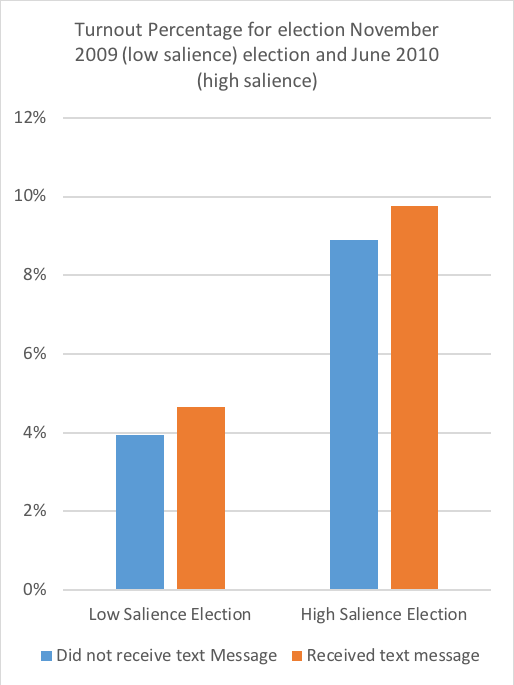
Text Messages for Voter Mobilization
Organization : Harvard Kennedy School
Project Overview
Project Summary
Registered voters were reminded about upcoming elections via “cold” text messages devoid of any personal contact.
Impact
The intervention increased participation by 0.7 percentage points among voters in a local election and by 0.9 percentage points in a state election.
Challenge
While potential voters may register and intend to vote, many registered voters ultimately do not participate in elections. In addition, previous studies have not addressed how the impact of the text messages may vary among causal voters compared to habitual voters. Casual voters are defined as those who had previously only voted in the presidential election or major elections. Habitual voters are defined as those who have a higher propensity to vote (in this case, those who voted in each of the four elections).
Design
This project aimed to increase voter turnout by sending registered voters “cold” text message reminders about upcoming elections. We define cold texts as text messages that have absolutely no prior or personal contact associated with them. In other words, people do not receive texts from an organization that registered them in person and do not give permission to receive text messages prior to Election Day. This method of voter outreach differs from mobilization efforts that are centered on social contact.
The first part of the project revolved around the November 2009 local elections in San Mateo County, California. We considered this a “low salience” election because of the low visibility, with little advertising or other electioneering activities. Registered voters in the treatment group received a text message at 1PM the Monday before Election Day with the following encouragement:
“A friendly reminder that TOMORROW is Election Day. Democracy depends on citizens like you – so please vote!”
Other voters received nothing at all. 99.8% of the text messages were delivered successfully.
The second part of the project involved higher salience elections: the June 2010 statewide primary elections in San Mateo County. It is considered higher salience because of the higher turnout and advertisement rates. At 1 PM the Monday before Election Day, registered voters in the treatment group received the same text message as the one quoted above. Other voters received nothing at all. 99.99% of all messages were delivered successfully.
Impact
In the first randomized evaluation (of the low salience local election), registered voters who received “cold” text messages were 0.72 percentage points more likely to vote than those who received no messages at all – 4.66% of registered voters who received texts voted, compared to only 3.95% of those who did not receive a text message.
In addition, we found that in the low salience election, the “cold” text messages were most effective among habitual voters. Among casual voters, the text messages had little effect in this experiment.
In the second randomized evaluation, which took place in high salience state elections in June 2010, registered voters who received “cold” texts were 0.86 percentage points more likely to vote than those who received no message at all – 9.8% of registered voters who received texts voted, compared to only 8.6% of those who did not receive a text message.
In the high salience election, the “cold” text messages were most effective among casual voters. Among habitual voters, the text messages had little effect in this experiment. This may be because habitual voters are not indifferent to voting in high salience elections (they care about voting), and thus do not benefit from reminders.

Impact: high salience experiment, 29,673 voters were randomly assigned to receiving reminder text message or not. Low salience experiment, 29,673 voters randomly assigned to receiving reminder text message or not.
Implementation Guidelines
Factors that are especially important to implementing the intervention effectively include:
- Verify phone numbers before sending the text messages. In this intervention, we used county list to eliminate individuals who did not provide a unique telephone number, and the firm MobileCommons then verified whether the phone numbers listed belonged to cellular phones.
- The text message reminder should be sent close to the event or activity time, while providing enough time for individuals to adjust their schedule to attend the event or perform the activity. In this intervention, we sent the text messages at 1:00 PM the day prior to the election.
- When sending reminders, target individuals who will benefit most. We observe, in the national election context that cold texts significantly increased turnout among casual voters (those who do not vote consistently in all elections and may have forgotten to vote), yet had low impact on habitual voters (those who were likely already aware of the election and planning to vote). However, in the local election context, cold text messages increased turnout among habitual voters by a substantial amount. In this case, the cold text message may not have been enough to convince the casual voter to vote, yet served as a helpful reminder to the habitual voter.
Project Credits
Researchers:
Todd Rogers Contact Harvard Kennedy School
Neil Malhotra Stanford Graduate School of Business
Melissa R. Michelson Menlo College
Ali Adam Valenzuela Princeton University


